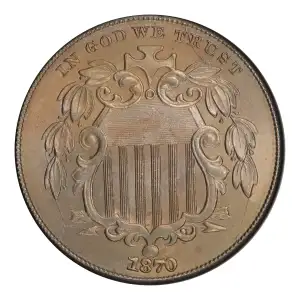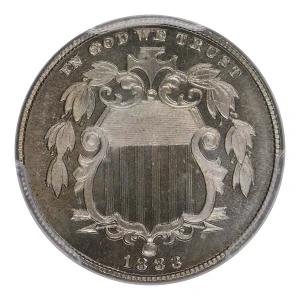Introduced in 1866, the Shield nickel was the first five-cent piece to be struck in a copper-nickel composition. Until that point, five-cent coins had been produced exclusively in silver. However, public hoarding of silver coins during the economic turmoil of the Civil War left relatively few coins in circulation. Philadelphia industrialist Joseph Wharton, who then controlled the U.S. domestic supply of nickel ore, advocated strongly for the production of a new nickel coin. The nickel three-cent piece had already been introduced a few years earlier with widespread public acceptance. Congress obliged, and the new nickel five-cent coin was authorized into law. Designed by James B. Longacre, the Shield nickel is one of the most patriotic coin designs of the 19th century. The obverse features a prominent shield modeled after the Great Seal of the United States. The upper part of the shield, known as the “chief,” is a series of fine horizontal lines that represents Congress, while the 13 stripes below symbolize the original 13 states. This combined motif connotes the strength of the government through the unity of the states. In heraldic engraving, vertical lines represent red, clear areas represent white, and horizontal lines represent blue. Thus, this motif is also strongly emblematic of the American flag. On either side of the shield are laurel branches representing victory. Above is a cross, and below are crossed arrows symbolic of peace but readiness for war. The reverse design features a large numeral 5 surrounded by 13 stars alternating with rays. Production of the Shield nickel continued until its replacement with the Liberty Head nickel in 1883.



